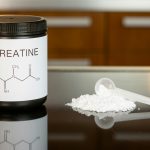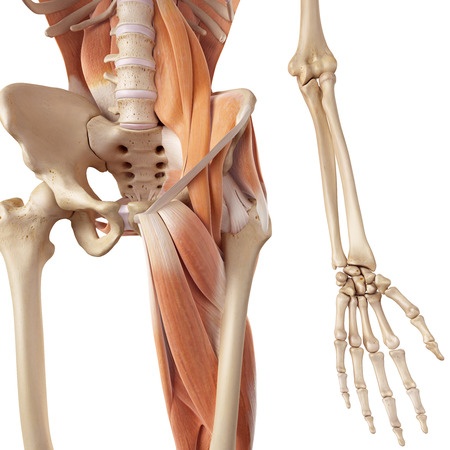
How many of the 11 muscles involved in hip flexion can you name from memory? It’s hard to remember them all! Yet it’s easy to see why so many muscles are needed for this motion. You hip flex every time you sit, squat, walk or ride a bike. And your clients are flexing their hips constantly during workouts while lunging, crunching, stepping up, etc.
To make it easier for your memory, here are tips on how to study according your level of anatomy knowledge. Pick which works for you and then we’ll review the muscles!
Beginner hip flexor muscle anatomy
If you’re just starting your anatomy journey, work on remembering the names of all 11 hip flexor muscles. Use acronyms to help you. Here are the letters to work with: AAA I GG PP R S T. Scroll down to see the muscle names that go with these letters.
Here’s a sample acronym: GAGA RAP TIPS
So, what are Lady Gaga’s rap tips? We’re not sure, but creating acronyms is helpful and fun!
Intermediate hip flexor muscle anatomy
Once you’ve memorized the 11 hip flexor muscles, see if you can learn the bones that each muscle attaches to. Making flashcards is an easy way to practice.
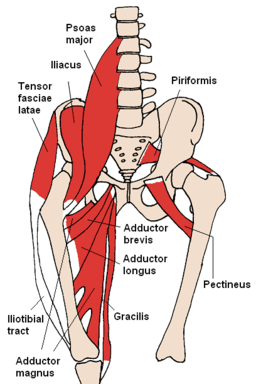
All of the hip flexor muscles attach from the pelvis or spine to the femur or tibia, which is how they influence hip flexion. Bypass the tricky bony landmark terms for now and familiarize yourself with just the two bones each muscle attaches to.
The bolded words in the descriptions below are there just for you intermediate anatomy student! Knowing which bones each muscle attaches to is helpful for creating basic hip flexor exercises and stretches. More to come on that in a future article…
Advanced hip flexor muscle anatomy
If you know all the hip flexor names and bones they attach to, that’s an awesome accomplishment! Now you’re ready to learn the specific bony landmarks for each of the 11 hip flexors. This is not a feat for the faint of heart!
The landmarks are tricky to learn, but they’re the key to really effective exercise programming. Some of the hip flexors are better at creating hip flexion when the hip is internally or externally rotated and some better in neutral. Abduction and adduction also influence the way these muscles function. So does the degree that the hip is flexed.
With advanced anatomy knowledge, you can create stretches and exercises that are strategic, specific and help clients overcome muscle imbalances quickly. Unfortunately, there’s no quick way to learn the exact muscle attachments.
Do this to help…
Find each specific muscle attachment listed below on yourself and a partner. Place the ends of a balloon, string or rubber band on each attachment site. Move the bones into internal and external rotation with hip flexion. Try adding some abduction or adduction with hip flexion. This will clue you in to the muscles abilities, which change as the position of the bones change. You’ll start to see the possibilities as you solidify your knowledge of the attachments and specific abilities of each muscle.
For example, psoas major and iliacus seem to be involved in external rotation of the femur because the lesser trochanter lines up with the other side of the muscle attachment more when the femur is externally rotated. In other words, it comes closer to the anterior (front) side of the body.
Hip flexor muscles and attachments
Each muscle below has the bones in bold for intermediate learners and the specific bony landmarks for advanced learners. I skipped origin vs. insertion because that just makes it more confusing and your muscles don’t really identify themselves that way anyhow… You can reference these amazing hip flexor muscles in any anatomy book. Anatomy coloring books are also a fun choice if you’re in the market.
Psoas Major
Spine: bodies of transverse processes of lumbar vertebrae
from/to
Femur: lesser trochanter
Iliacus
Pelvis: iliac fossa
from/to
Femur: lesser trochanter
Tensor fasciae latae
Pelvis: iliac crest, posterior to the ASIS
from/to
Tibia: iliotibial tract
Sartorius
Pelvis: anterior superior iliac spine (ASIS)
from/to
Tibia: proximal, medial shaft at pes anserine tendon
Rectus femoris
Pelvis: anterior inferior iliac spine (AIIS)
from/to
Tibia: tibial tuberosity (via patella and patellar ligament)
Gluteus medius (anterior fibers)
Pelvis: gluteal surface of ilium between posterior and anterior gluteal lines, just below the iliac crest
from/to
Femur: lateral aspect of greater trochanter
Gluteus minimus
Pelvis: gluteal surface of ilium between anterior and inferior gluteal lines
from/to
Femur: anterior aspect of greater trochanter
Adductor longus (assists)
Pelvis: pubic tubercle
from/to
Femur: medial lip of linea aspera
Pectineus (assists)
Pelvis: superior ramus of pubis
from/to
Femur: pectineal line
Adductor brevis (assists)
Pelvis: inferior ramus of pubis
from/to
Femur: pectineal line and medial lip of linea aspera
Adductor magnus (assists)
Pelvis: inferior ramus of pubis, ramus of ischium and ischial tuberosity
from/to
Femur: medial lip of linea aspera and adductor tubercle
pop quiz answer: Sartorius!
Hip Flexor Exercises
We know that our sedentary population can often produce shortened or tight hip flexors that our clients might complain about.
What if “tight” hip flexors were actually weak? Any combination of the 11 hip flexor muscles mentioned above can be weak in a client’s body, causing the other muscles to be overactive and shorten up. Tightness or tension is how your muscles hold your bones together. Without tension, we’d be a pile of bones! But, certain muscles can hold too much tension or be too weak, creating dysfunction.
The more muscles involved in a motion, the higher the potential for dysfunction. Sometimes it’s a few of the muscles within the same hip that are weak, causing others to be short and tight. It could also be that certain muscles in one hip are weak, causing tightness in the other hip. There are indeed a lot of “cooks in the kitchen”, warranting some coordination. That’s where the personal trainer enters the scene and conducts an informed assessment of the situation.
Since hip flexion happens every time we sit, squat, and step it requires many muscles to effectively create this motion.
Knowing how each hip flexor muscle contracts or shortens is a great way to identify weakness and strengthen the muscles needing it most. Take gluteus medius as an example. It attaches from the iliac crest to the greater trochanter of the femur. Because of where it attaches it can flex the hip, abduct the hip, and internally rotate the hip. This makes it unique and different from the tensor fasciae latae which also flexes and abducts the hip, but internally rotates the hip instead of externally.
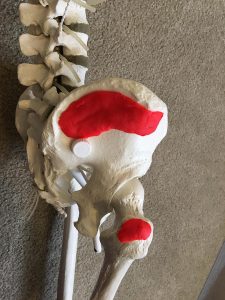
If it seems complicated, hang with me a little longer…
Creating Specific Hip Flexor Exercises
Doing an exercise that combines all three of the motions of the gluteus medius is the best way to strengthen that muscle. A classic exercise is side-lying leg lifts.
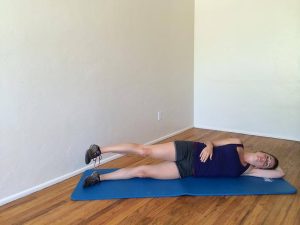
Keeping the motion small and controlled helps you see if the right or left side is stronger than the other. Analyze potential imbalance by observing the following:
- ask your client if one side feels stronger
- ask your client if one side feels tighter
- notice if one side moves differently than the other
- notice if you see compensation happening in the spine on one side and not the other
If there is a difference, encourage them to create symmetry between both sides by focusing on what they feel. You can also help guide them using your anatomy knowledge. Anytime you identify asymmetry in an exercise, going slower and using less motion can help correct it.
Have your client perform the exercise at 10-15% of what they did before and then see if anything changes. The body does what it can to meet the brains desires. Reducing the demand and then slowly building back up is what corrective exercise is all about.
Learning the muscle attachments makes the unique movements of each muscle easier to identify and allows you to create specific corrective exercises for your clients. You can also use your knowledge of motion to create more specific hip flexor exercises.
If you have some catching up to do with regard to anatomy knowledge, this next part is for you!
Simple Sample Hip Flexor Exercises
Doing hip flexion is how you strengthen the hip flexors, right? Pretty simple. Leg lifts and marching are two common exercises that are applied. To get more specific add the other motions that happen in combination with hip flexion (internal/external rotation, abduction/adduction). Try various degrees of hip flexion since some of the muscles work more than others as hip flexion increases.
I demonstrate this concept in these videos quickly to keep it short and sweet. When you do the exercises with clients, have them hold the various positions for 5-10 seconds or do 10-15 repetitions, depending on their goals. As with any new exercise try them yourself first.
Hip Flexor Flexibility
Hip flexor stretches may not always get the results your personal training clients desire, but they can – if you add the right “twist”. Before we talk about how to effectively stretch the hip flexors – let’s let them off the hook, ok? Tight (read: short) hip flexors get unfairly blamed for many pains and injuries.
Since hip flexion happens every time we sit, squat, and step, the muscles involved do work hard and could become short and/or overactive. It’s important to note that a muscle’s role is to be tense and active in some sense. If your muscles weren’t “tight” then you would literally be a pile of bones.
In addition to that truth, a very important question needs to be asked. When a client says, “My hip flexors are tight” do they mean that all 11 hip flexors or short and overactive? Or might it be just 3-4 of them? Or 8 of them? And are the same hip flexors overactive on both sides of the body?
Hip flexion is a movement with many muscles and deserves a closer look when considering stretches. That’s where you, the muscle expert, come into play!
Stretching the Hip Flexors
Doing hip extension is the most basic way to stretch the hip flexors. If this isn’t working, it’s time to get more specific. To stretch the various hip flexors in a more targeted way you can abduct or adduct the leg and also internally or externally rotate it. Hip flexion is combined with these various motions.
Beyond this, knowing how each hip flexor muscle contracts or shortens is an important step to more effectively stretch each of the 11 hip flexor muscles. If you know which muscle is tight, then you can guide a client into stretching it by having them do the opposite motion of the tight muscle.
For example, the gluteus medius (anterior fibers) performs hip flexion but also abduction and internal rotation. An ideal stretch would engage the opposite motions of the tight muscle to be most effective.
- Stretch the gluteus medius by placing the hip in extension (behind the body), adduction (pulled towards the midline of the body), and external rotation (rotated away from the body).
How would you know the gluteus medius specifically is short and needs stretching? It’s tricky to know which muscle or muscles are shortened, but performing movement assessments such as the Overhead Squat Assessment can help reveal this information. Once you determine which muscles are likely to be short/tight or long/weak, then you can implement stretching and strengthening exercises to balance the body as much as possible.
Important Side Note: Don’t be fooled by stretch or exercise isolation claims. i.e. you can stretch just the psoas major or just the TFL. You’ll also be stretching several other muscles. The more you understand anatomy and muscles attachments the more clear this becomes.
Active Hip Flexor Stretches
Active hip flexor stretching is beneficial because the body is facilitating the stretch without passive forces. When contracting the hip extensors the hip flexors naturally get stretched. You can have clients stretch their hip flexors as a group actively by doing these exercises. Add hip internal/external rotation and abduction/adduction to see how it changes the feeling of the exercise and stretch for your clients. Have them hold these exercise positions for 10-20 seconds like you would a passive stretch.
This video briefly shows you these three sample stretch exercises. How you apply them (reps, duration, etc.) depends on the client goals.
-
- Bird Dog
- Superman
- Bridges
Passive Hip Flexor Stretches
The classic way to stretch is to position the body as desired and hold it for 20-30 seconds with an outside passive force such as your hand or the floor. These work well for some people and not for others. Be cautious when imposing a stretch without actively contracting other muscles to support it. If you over stretch a muscle it can become injured.
This video shows two classic hip flexor stretches briefly. Make them more effective by using the muscles on the opposite side of the joint to stay in control of the motion. For example, cue the client to contract their gluteal muscles and hamstrings.
- Lunge hold standing and kneeling
- Knee flexion and hip extension
Knowing the muscles and anatomy of hip flexion is an important component in addressing “tight hip flexors” more effectively. Understanding the motion of hip flexion is the other crucial piece.
IT’S NEVER TOO LATE TO STRENGTHEN YOUR ANATOMY KNOWLEDGE!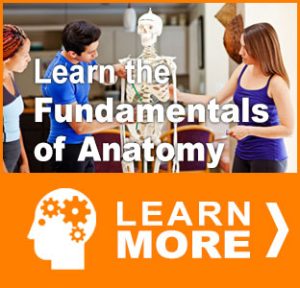
BE A CERTIFIED PERSONAL TRAINER. CLICK HERE TO SEE HOW >>
Reference
Biel, Andrew. 2014. Trail Guide to the Body. Boulder: Books of Discovery



